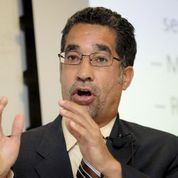Why are so many Americans in prison?
Between 1975 and 2007, the American incarceration rate increased nearly fivefold, a historic increase that puts the United States in a league of its own among advanced economies. The United States incarcerates more people today than it ever has, and it stands out as the nation that most frequently uses incarceration to punish those who break the law.
 To get to the bottom of why this has happened, Michael A. Stoll, a UCLA professor of public policy and the chair of that department in the Luskin School of Public Affairs, and his UC Berkeley colleague, public policy professor Steven Raphael, were able to identify factors that explain the dramatic rise in the U.S. jail population that occurred over this time period.
To get to the bottom of why this has happened, Michael A. Stoll, a UCLA professor of public policy and the chair of that department in the Luskin School of Public Affairs, and his UC Berkeley colleague, public policy professor Steven Raphael, were able to identify factors that explain the dramatic rise in the U.S. jail population that occurred over this time period.

UCLA's Michael A. Stoll (right) and his UC Berkeley research collaborator Steven Raphael have zeroed in on what has caused a rapid boom in the prison population in America.
In their new book, "Why Are So Many Americans in Prison?" (Russell Sage Foundation, 2013), they evaluated changes in crime patterns, enforcement practices and sentencing laws to reach a sobering conclusion: So many Americans are in prison today because the United States has chosen, through public policies, to put them there.
 While many cite, among other reasons, the deinstitutionalization of the mentally ill that occurred between 1950s-1970s, the introduction of crack into America’s cities, demographics and racism as reasons underying this spike in the prison population, there’s no solid evidence that such factors by themselves led to the prison boom, the longtime collaborators told an audience, dispelling such myths with numerous statistical analyses.
While many cite, among other reasons, the deinstitutionalization of the mentally ill that occurred between 1950s-1970s, the introduction of crack into America’s cities, demographics and racism as reasons underying this spike in the prison population, there’s no solid evidence that such factors by themselves led to the prison boom, the longtime collaborators told an audience, dispelling such myths with numerous statistical analyses.
Stoll and Raphael explained how they arrived at this answer at a presentation Jan. 15 hosted by the department. Both scholars have written extensively over the past decade about the causes, costs and consequences of mass incarceration in the U.S.
 While many cite, among other reasons, the deinstitutionalization of the mentally ill that occurred between 1950s-1970s, the introduction of crack into America’s cities, demographics and racism as reasons underying this spike in the prison population, there’s no solid evidence that such factors by themselves led to the prison boom, the longtime collaborators told an audience, dispelling such myths with numerous statistical analyses.
While many cite, among other reasons, the deinstitutionalization of the mentally ill that occurred between 1950s-1970s, the introduction of crack into America’s cities, demographics and racism as reasons underying this spike in the prison population, there’s no solid evidence that such factors by themselves led to the prison boom, the longtime collaborators told an audience, dispelling such myths with numerous statistical analyses.And while "race does matter," Stoll said, citing the disproportionately high incarceration rate of African American males, "this (the rapid rise in prison population) is an American problem and requires an American solution," pointing out that the U.S. incarceration rate is "unparalleled" (more than 700 per 100,000), compared to the rates in Europe and the rest of the world, even as crimes rates in the U.S. dipped to historic lows.
Stoll and Raphael found through their research is that since the 1980s this spike in the incarceration rate is "attributable to changes in sentencing policy," which has resulted in longer sentences, for example.
Mandatory minimum penalties, repeat offender statutes, new sentencing guidelines, "get-tough-on-crime" policies and other politically driven efforts to address crime have only compounded the problem, they said, pushing the system to the point where the cost of maintaining such a high incarceration rate has begun to outweigh the benefits and inflict broad social costs, particularly among minority communities.
In their book, Stoll and Raphael explore alternatives aimed at reducing this incarceration trend and call for policymakers to consider other measures, including expanded policing, drug court programs and reform of sentencing laws.
_________________________________________________________________________
The entire discussion is available on UCLA Luskin's iTunes U channel. This piece was adapted from one that was posted on Luskin’s website.




